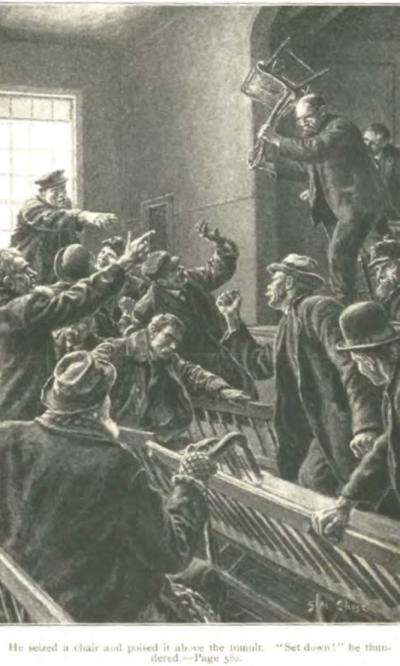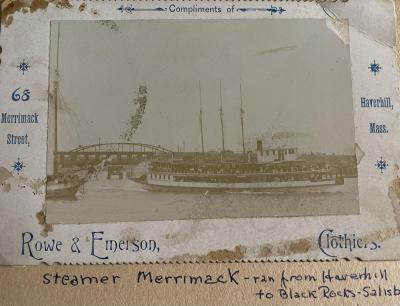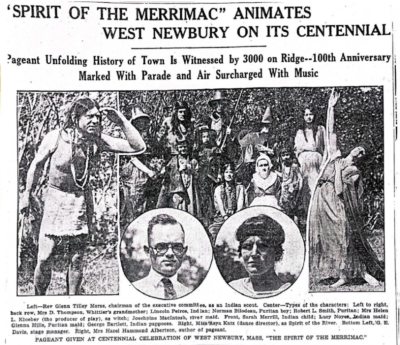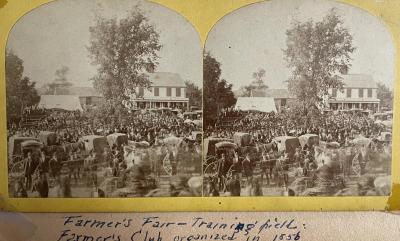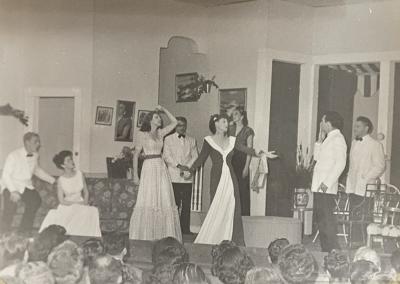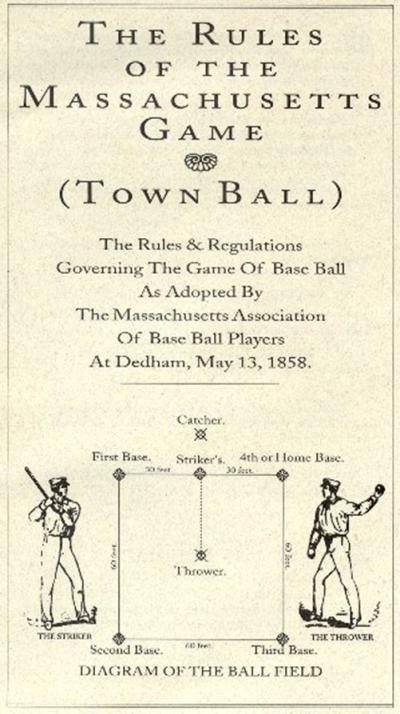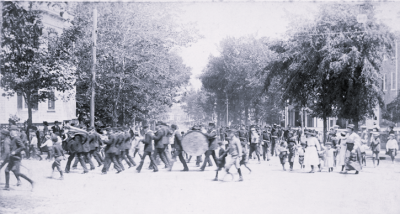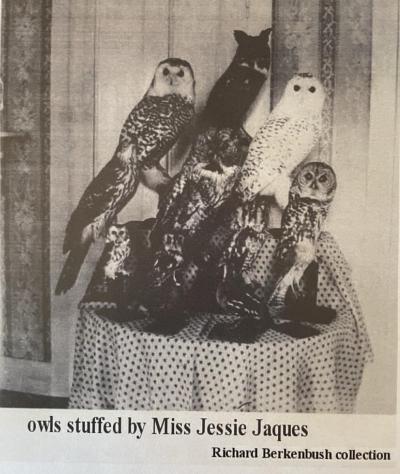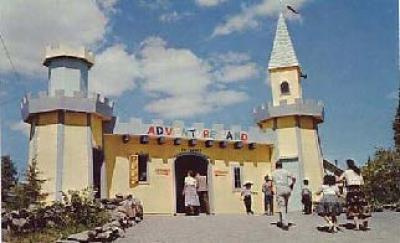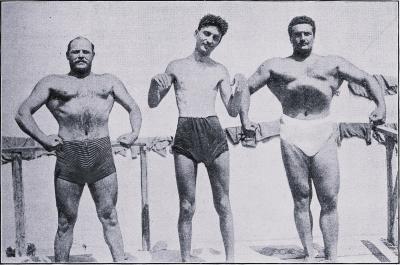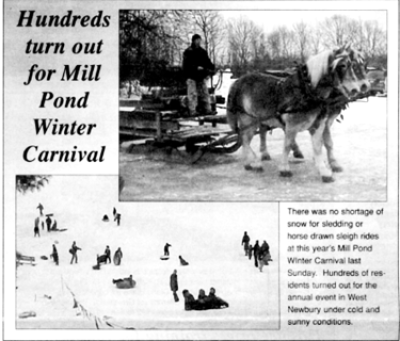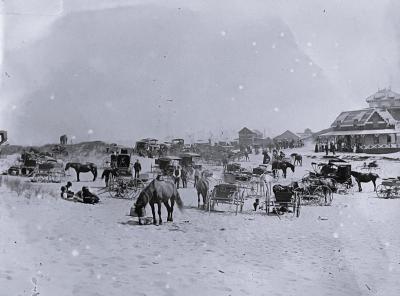A Historic Minute 2023–Entertainments
In 2023, the Historical Commission's monthly Minute Histories are about entertainments in West Newbury over the years. Scroll down to find links to 12 stories below--
Source: Town Meeting Day by Haverhill’s Sidney M. Chase in Scribner's, G.A.R. Library
January’s Minute History is about West Newbury town meeting, which, whether intended or not, has been well-documented as a source of amusement in and out of Town. One mid-19th century West Newbury town meeting, fondly remembered decades later in a local newspaper article, was largely derailed by the peanut man, who (along with some fighting dogs) unleashed chaos at that memorable event. In the mid-20th century, a New York Times article provided the nation a window into West Newbury town meetings in that era, when it was said the “hours at Town Meeting on rock-bottomed seats offer drama that dims television or dulls radio into oblivion.” Later, town moderator Julian Steele, who famously asked an excessively expostulating town meeting participant, “Why be so difficult when with a little trying you could be impossible?” explained to the Boston Globe, “There are times when a little humor should be introduced into a meeting, for instance, when there is excessive wrangling over an issue.”
February’s story revisits delightful summer days on the steamer Merrimac. In the warm seasons between June 6, 1892 and September 13, 1910, West Newbury’s townspeople boarded the 200-ton stern wheeler, exchanging daily chores and cares for glorious adventures on the river and at the seaside. The Merrimac sailed between Haverhill and Black Rocks in Salisbury, stopping in Newburyport and sometimes other river towns along the way. Although moonlight rides set to band music were themselves worth the 25¢ fare, the Merrimac’s principal destination was Salisbury Beach, then a wildly popular resort. For many years, townsfolk embarked on the Merrimac for August’s “West Newbury day.” The Merrimac survived a shipwreck in West Newbury in 1899, but succumbed to competition from electric trollies in 1910.
March’s Minute History concerns the Town’s centennial. In 1919, when the Town had lost manufacturing and population, almost every citizen—from Girl Scouts to grandsires—joined in an extraordinary endeavor to celebrate West Newbury’s 100th anniversary. For three days in August, Town buildings were decorated, and to greet returning WWI veterans, both townsfolk and their houses wore “Welcome Home” messages. On the morning of Saturday, August 23, West Newbury began the celebration with a band concert and the best ever parade in Town. That afternoon, a cast of some 390 townspeople (plus an orchestra and vocalists) put on an unforgettable pageant for an audience estimated at 3-4,000. The remaining two days were filled with events honoring veterans, including another large parade. A brilliant reception and merry dance at Town Hall topped it all off. Said the Boston Globe, “Here was that community spirit of which we hear so much and see so much less.”
April’s Minute History is about the Farmer's Club. If, as was said in the mid-19th century, “No town much interested in agriculture should be without a Farmer’s Club,” West Newbury led the way. On December 6, 1856, the West Newbury Farmers Club was set into motion, the first in Essex County. In quiet winter months farmers met to consider issues of husbandry—and to socialize. Then and now, the Farmers’ Club was most known for its September fairs. They began around 1860 as picnics at the Ordway homestead with parlor displays of “brobdingnagian” vegetables and many now-lost varieties of apples and other fruits. As the fair grew ever bigger and better, hosting thousands, logistics became increasingly challenging. In 1894, a printed “Arrangement of Committees” detailed the purpose and membership of 46 different fair committees. With attendance declining, the Club held its final fair on the Training Field in 1901 and disbanded shortly thereafter.
May’s Minute History concerns summer stock theatre in West Newbury. From 1947 through 1949, West Newbury was on the map as a stop on New England summer theatre’s straw-hat circuit. A non-profit, community-sponsored venture featuring a core troupe of Broadway professionals, the Town Hall Players brought culture and vibrancy—and much drama to Town Hall, the Training Field, West Newbury households, and the entire lower Merrimack Valley. West Newbury summer theatre flared with intensity, its brevity testimony to grand scale vision and ambition in a very small town.
June’s story concerns baseball. Between the late 1860s and the 1890s, baseball mania enthralled New England, including West Newbury. Town fans had much to brag about: in the 1860s-70s the powerhouse West Newbury Rocket Club punched above their weight, trouncing teams from much larger cities and towns. They “played with most of the crack nines in New England but were never defeated.” Baseball’s apogee in West Newbury occurred on June 11, 1894 at Griffin’s Field on Main Street, now the Carr Post site. That afternoon the “old Rockets,” who had not played in 22 years, met the then-mighty West Newbury Blues. The Town turned out, the Cadet Band played, and at the game’s end, both teams followed the band in a parade to the G.A.R. Hall for an oyster stew supper to celebrate. By 1895, West Newbury no longer had a home team. Griffin Field’s new owner, who intended to use the land for Carr Post, agreed to “one good game” for the year there on September 14, 1895.
July’s Minute History features the West Newbury Cadet Band, which from 1894 to around 1905 enlivened the occasion—be it a summer’s Sunday school outing or a winter concert. Comprised primarily of a core group of brass, woodwind, and drum players from West Newbury, the band also included an occasional violin or banjo as well as musicians from neighboring towns. A for-fee venture of some 18 to 25 fellows whose day jobs included farming and shoemaking, the band gave concerts in Town Hall and on the Training Field. It sponsored masquerade balls in winter and an annual trip up and down river on the steamer Merrimac. It celebrated Memorial Days and the 4th of July, and marched in many a parade. One of the band’s final reported engagements occurred in October 1905, when it joined friends and family serenading First Parish newlyweds. Other bands came and went thereafter, but none the same as the West Newbury Cadet Band
August’s Minute History is about one of the hobbies popular in West Newbury in earlier times. Of the peculiar hobbies enjoyed in Victorian times, not least creating art from seaweed and human hair, taxidermy is perhaps best documented in West Newbury. One author explained that in the 19th century, taxidermy was everywhere from natural history museums, to home décor, fashion, art and popular culture. In West Newbury, the hobby often was a family affair. Brothers Frank and William Sharples, both shoemakers, were locally renowned for their taxidermy skills. The father-daughter taxidermy team Alonzo and Jesse Jaques specialized in small mammals and birds, respectively. The Town’s most prolific and professional taxidermist was West Newbury-born and -bred Charles Frederic Newell, who started his taxidermy career in Maine and New Brunswick and later opened a shop in Merrimac, where he stuffed all creatures great and small, ranging from armadillos to sturgeon.
September’s tale is about Adventure Land, where, for a handful of summers starting in 1957, West Newbury was home to cowboys, Indians, monkeys, and bears—not to mention the pirate ship, the railroad, and the big blue house-sized shoe. All were part of “America’s Most Fabulous Family Entertainment,” which was located on Scotland Road across I-95, in the corner of West Newbury that now is home to the State Police barracks. Although heralded upon its opening as the next Disneyland, Adventure Land was on the market for sale or lease before the 1961 season and in foreclosure by 1965. Adventure Land lives in the memories of children who visited and young adults who worked there. And, thanks to Pentucket High School filmmakers, anyone can visit Adventure Land today, free of charge, just by clicking here.
Source: Wikimedia Commons
October's story concerns physical culture. In the latter parts of the 19th and into the 20th centuries, classes in such arts as oratory and physical culture (aka fitness) were important aspects of self-improvement across the nation and in West Newbury. In 1890, the West Newbury Messenger suggested “the idea of furnishing a portion of the empty shoe factory on Post Office square for the purpose of Y.M.C.A. rooms” with “a simple gymnasium.” By 1904, Post Office Square boasted an Athletic Club, residing on the second floor of what had been Bailey’s grocery, and in 1905 it was reported that the West Newbury Physical Culture Club was gaining members. While the concept of manly men was largely a matter of consensus (except, perhaps, in the arena of individual sports and diet), the question of womanly women was decidedly unsettled, particularly in terms of physical culture. It was not until the 1920s that West Newbury women began to participate in sports on a largely equal, if separate, basis as their male counterparts.
November's story concerns amusements made possible by long wintery months of ice and snow, which have in good measure vanished as West Newbury warms in this era of climate change. In 1924, a commentator in the Newburyport Daily News and Herald recalled long-gone times before the 1870s when as a boy he skated several times across the mouth of the Merrimack between the Newburyport wharves and the Salisbury shore. “Then the one horse sleigh was in its prime and glory,” he wrote. “No matter how cold it was, a fellow did not mind ‘Jack Frost’ if he had a pretty girl alongside of him as his partner, gliding over the crystal path. ‘But they, too, have changed.’”
December’s tale recalls summer’s high point between the mid-19th century and the late 1930s, when West Newbury’s “Plum Island Gathering” served as the Town’s collective vacation day. According to Leonard Woodman Smith, who was born here in 1844 and attended the outing well into his 60s, West Newbury Day at Plum Island was “the great play day of the year,” eagerly anticipated by young and old. Early in the morning of the appointed day, all manner of carriages and horse-drawn conveyances carrying most of the Town and makings for a picnic lined up for the slow procession through Newburyport and on to the island. In a space between the dunes, the women laid white tablecloths in a long line end-to-end, and hundreds of townsfolk at each side of the makeshift table enjoyed the feast—and each others’ company during a day out at the beach.


